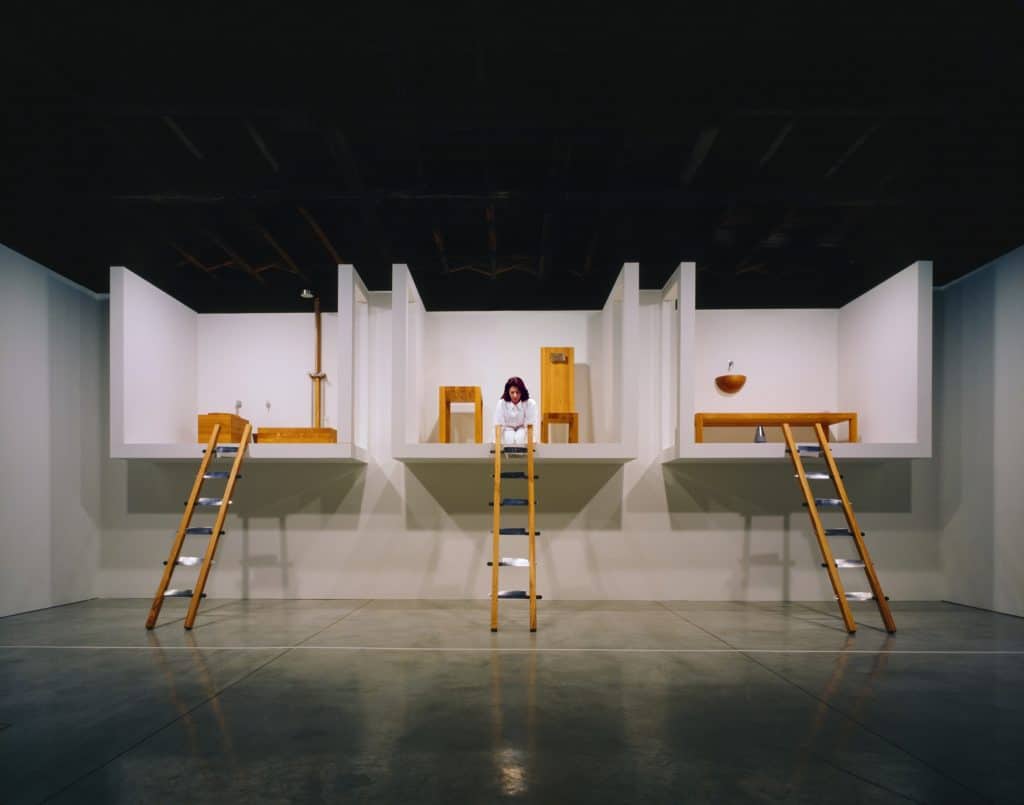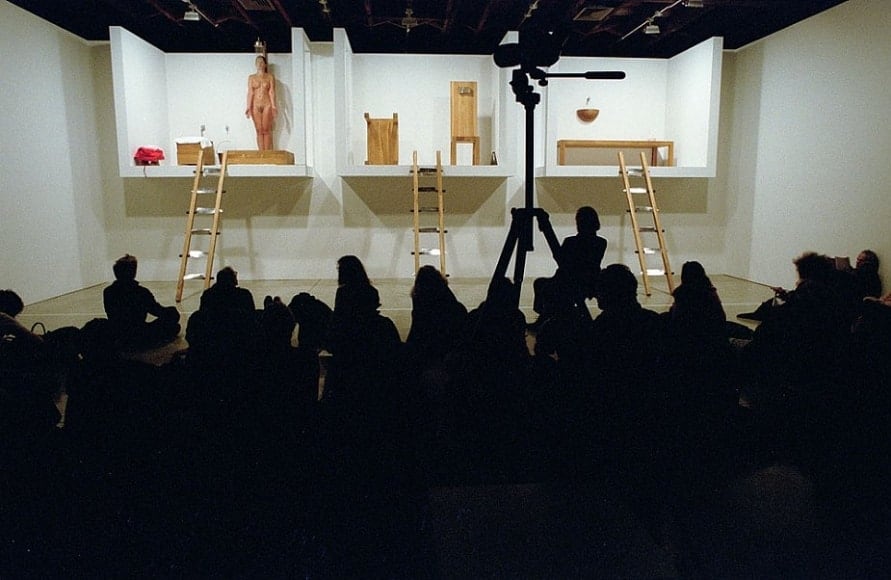Articles & Features
Iconic Artworks: The Marina Abramovic Performance ‘The House With The Ocean View’

Courtesy: Sean Kelly, New York
By Naomi Martin
“House With Ocean View was for me an experiment. When I came to New York, it was just after September 11, and I found New York so much changed. I found New York and people living here different, more emotional, more vulnerable, more spiritual.”
Marina Abramovic
Our ‘Iconic Artworks’ series delves into the stories behind some of the most iconic works of art ever made. What were the conditions that contributed to the creation of the work, what was the artist experiencing at the time, and what was being transmitted?
This week, we take a look at one of Marina Abramovic‘s most compelling performance pieces: The House With The Ocean View.
The Grandmother of Performance Art
Stabbed, starved, burnt, cut and stripped naked for her art, Marina Abramovic is one of the most influential female artists of her time, the self appointed ‘grandmother of performance art’. The Serbian artist is known for her seminal performance pieces challenging her own body, which she uses both as a subject and artistic medium.
Abramovic’s performances often incorporate dangerous and demanding undertakings, thus pushing her physical and mental boundaries to explore the themes she considers. Abramovic is also renowned for her artistic collaboration and love affair with German performance artist Ulay, which ended with the performance The Lovers – a striking endeavour where the two artists walked for 90 days from opposites sides of the Great Wall of China, to meet up in the middle and put an end to their relationship.
In one of her earlier performances, Rhythm 10, Abramovic used a series of 20 knives to stab the spaces between her fingers, occasionally drawing blood on herself – following this 1972 performance, she raised the level of risk. During the performance Rhythm 5, she lost consciousness while laying down in the centre of a burning star, and with Rhythm 0 she transformed herself into an object at the mercy of the audience, where she was cut, held at gunpoint and assaulted.
An Experiment In Personal Purification

Courtesy: Sean Kelly, New York
“If I don’t eat, and I don’t talk, and I purify myself, could I also purify space in this way?”
In 2002, Marina Abramovic lived on three platforms for 12 days, consisting of three units representing her house – a bathroom, a living room and sleeping room – installed within Sean Kelly Gallery in New York. For Abramovic, The House With The Ocean View was an experiment in personal purification through restrictions, and an attempt to shift both her own energy field and the audience’s. During the 12 days of the performance, the artist never left the gallery, did not eat any food and did not drink anything else but water.
The three units were standing five feet above the ground, with a gap of about two feet in between each room. Sparsely furnished, they contained a rudimentary wooden bed with no mattress, a chair, a table, shelves containing a different outfit for each day, a sink, a shower, a toilet, and a ticking metronome marking the passage of time. The only escape? Ladders with sharpened butcher knives for rungs, upturned. All the walls were pure white and all the furnishings in warm wood, with hard edges, the plumbing in stainless steel. A white line was drawn on the floor in front of the platform, marking a limit the audience was not allowed to cross.
Abramovic’s only material possessions for 12 days included: “sink, bed, chair with mineral pillow, table, toilet, shower, seven pairs of trousers in seven colours, seven shirts in seven colours, six white towels, metal bucket, metronome, bar of natural soap, bottle of rose water, bottle of pure almond oil.”
“I think when they saw me so vulnerable, so open, the response was like an avalanche of emotion or an ocean. That was the title of the piece, ‘The House With the Ocean View,’ and the ocean was their minds. They helped me through.”
Marina Abramovic
An Escape From Fear and Confusion
Every day, the artist would put on a different coloured outfit, and every single thing she would do, including showering, sleeping and using the toilet, would be open to the eyes of the audience, able to watch her through a high-powered telescope. Abramovic also required the gallery owner and employees to sign a contract, bounding them never to interfere with the performance, regardless of what might happen. To enter The House With The Ocean View, the public would have to respect two conditions: No talking; establishing only an energy dialogue with the artist.
The performance was conceived as a gift for New York City post 9/11, through which Abramovic sought to provide a safe space of attention, connection, rest and meditation – an escape from the overwhelming fear and confusion of the period. The piece was not about the artist starving herself, but about changing and purifying the atmosphere, disciplining her body in order to reach a different sphere. The House With The Ocean View was a statement of commitment, vulnerability and intimacy, where the artist succeeded in creating an atemporal space, about pure presence.

Courtesy: Sean Kelly, New York
The viewers were essential to the performance, invited to come spend as much or as little time as they would like to, and to appreciate only the silent communion of the performer audience relationship in the intimacy of the space. But, paradoxically, there could be no interaction between the two parties, creating a tension between isolation and interaction. With this piece, Abramovic succeeded in creating an energy field, an ethereal space that would change the very attitude of the people coming to see her.
On the last day of the performance, a weak-bodied but strong-minded Marina Abramovic stood up in front of the 200 people who came to see her, and talked, for the first time in 12 days: “Dear artists, dear friends, dear public. I am sorry to disappoint you by not using the knife-ladder. With your mind you can do anything. […] I want to dedicate this work to New York and the people of New York. In a city that has no time I wanted to create an island of time.”
The House With The Ocean View is among the most captivating performance pieces ever created, a declaration of transparency and exchange of energy between the artist and her audience. In 2018, the piece was replicated at Palazzo Strozzi in Firenze, Italy, as part of a ‘reperformance program’, recreating some of Abramovic’s key performances with trained actors. From the 4th to the 16th of December 2018, Finnish performer Tiina Pauliina Lehtimäki reproduced the Abramovic performance, staying in isolation for 12 days.

Courtesy: Sean Kelly, New York
Relevant sources to learn more
Marina Abramovic on performing Rhythm 0 in 1974
Iconic Artworks: Basquiat’s Undiscovered Genius of the Mississippi Delta
Iconic Artworks: Kazimir Malevich’s Black Square